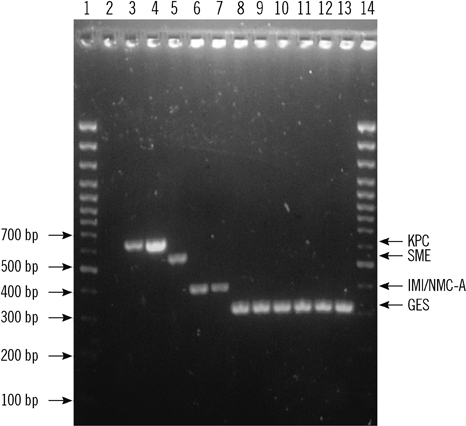Ann Lab Med.
2012 Sep;32(5):359-361. 10.3343/alm.2012.32.5.359.
Multiplex PCR for Rapid Detection of Genes Encoding Class A Carbapenemases
- Affiliations
-
- 1Department of Laboratory Medicine, CHA Bundang Medical Center, CHA University, Seongnam, Korea. hlseo@cha.ac.kr
- 2Department of Laboratory Medicine, CHA Gumi Medical Center, CHA University, Gumi, Korea.
- KMID: 1387351
- DOI: http://doi.org/10.3343/alm.2012.32.5.359
Abstract
- In recent years, there have been increasing reports of KPC-producing Klebsiella pneumoniae in Korea. The modified Hodge test can be used as a phenotypic screening test for class A carbapenamase (CAC)-producing clinical isolates; however, it does not distinguish between carbapenemase types. The confirmation of type of CAC is important to ensure optimal therapy and to prevent transmission. This study applied a novel multiplex PCR assay to detect and differentiate CAC genes in a single reaction. Four primer pairs were designed to amplify fragments encoding 4 CAC families (SME, IMI/NMC-A, KPC, and GES). The multiplex PCR detected all genes tested for 4 CAC families that could be differentiated by fragment size according to gene type. This multiplex PCR offers a simple and useful approach for detecting and distinguishing CAC genes in carbapenem-resistant strains that are metallo-beta-lactamase nonproducers.
Keyword
MeSH Terms
Figure
Reference
-
1. Patel G, Bonomo RA. Status report on carbapenemases: challenges and prospects. Expert Rev Anti Infect Ther. 2011. 9:555–570.
Article2. Gupta N, Limbago BM, Patel JB, Kallen AJ. Carbapenem-resistant Enterobacteriaceae: epidemiology and prevention. Clin Infect Dis. 2011. 53:60–67.3. Miriagou V, Cornaglia G, Edelstein M, Galani I, Giske CG, Gniadkowski M, et al. Acquired carbapenemases in Gram-negative bacterial pathogens: detection and surveillance issues. Clin Microbiol Infect. 2010. 16:112–122.
Article4. Cornaglia G, Rossolini GM. The emerging threat of acquired carbapenemases in Gram-negative bacteria. Clin Microbiol Infect. 2010. 16:99–101.
Article5. Ambretti S, Gaibani P, Caroli F, Miragliotta L, Sambri V. A carbapenem-resistant Klebsiella pneumoniae isolate harboring KPC-1 from Italy. New Microbiol. 2010. 33:281–282.6. Villegas MV, Lolans K, Correa A, Kattan JN, Lopez JA, Quinn JP. First identification of Pseudomonas aeruginosa isolates producing a KPC-type carbapenem-hydrolyzing β-lactamase. Antimicrob Agents Chemother. 2007. 51:1553–1555.7. Wei ZQ, Du XX, Yu YS, Shen P, Chen YG, Li LJ. Plasmid-mediated KPC-2 in a Klebsiella pneumoniae isolate from China. Antimicrob Agents Chemother. 2007. 51:763–765.8. Yigit H, Queenan AM, Anderson GJ, Domenech-Sanchez A, Biddle JW, Steward CD, et al. Novel carbapenem-hydrolyzing β-lactamase, KPC-1, from a carbapenem-resistant strain of Klebsiella pneumoniae. Antimicrob Agents Chemother. 2001. 45:1151–1161.9. Rhee JY, Park YK, Shin JY, Choi JY, Lee MY, Peck KR, et al. KPC-producing extreme drug-resistant Klebsiella pneumoniae isolate from a patient with diabetes mellitus and chronic renal failure on hemodialysis in South Korea. Antimicrob Agents Chemother. 2010. 54:2278–2279.10. Roh KH, Lee CK, Sohn JW, Song W, Yong D, Lee K. Isolation of a Klebsiella pneumoniae isolate of sequence type 258 producing KPC-2 carbapenemase in Korea. Korean J Lab Med. 2011. 31:298–301.11. Thomson KS. Extended-Spectrum-β-Lactamase, AmpC, and Carbapenemase issues. J Clin Microbiol. 2010. 48:1019–1025.
Article12. Pasteran F, Mendez T, Guerriero L, Rapoport M, Corso A. Sensitive screening tests for suspected class A carbapenemase production in species of Enterobacteriaceae. J Clin Microbiol. 2009. 47:1631–1639.13. Girlich D, Poirel L, Nordmann P. Novel ambler class A carbapenem-hydrolyzing β-lactamase from a Pseudomonas fluorescens isolate from the Seine River, Paris, France. Antimicrob Agents Chemother. 2010. 54:328–332.14. Henriques I, Moura A, Alves A, Saavedra MJ, Correia A. Molecular characterization of a carbapenem-hydrolyzing class A β-lactamase, SFC-1, from Serratia fonticola UTAD54. Antimicrob Agents Chemother. 2004. 48:2321–2324.
- Full Text Links
- Actions
-
Cited
- CITED
-
- Close
- Share
- Similar articles
-
- Evaluation of the Efficacies of Rapid Antigen Test, Multiplex PCR, and Real-time PCR for the Detection of a Novel Influenza A (H1N1) Virus
- Comparison of R-mix Virus Culture and Multiplex Reverse Transcriptase-PCR for the Rapid Detection of Respiratory Viruses
- Rapid Molecular Approach for Simultaneous Detection of
Salmonella spp.,Shigella spp., andVibrio cholera - Evaluation of Two Commercial Kits for Rapid Detection and Typing of Carbapenemase in Carbapenem-Resistant Enterobacterales
- Simultaneous detection and subtyping of porcine endogenous retroviruses proviral DNA using the dual priming oligonucleotide system


